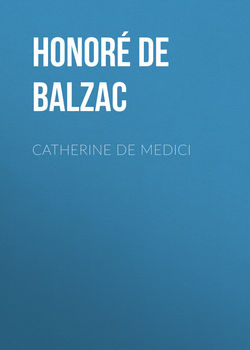Catherine De Medici

Реклама. ООО «ЛитРес», ИНН: 7719571260.
Оглавление
Honoré de Balzac. Catherine De Medici
INTRODUCTION
PART I. THE CALVINIST MARTYR
I. A HOUSE WHICH NO LONGER EXISTS
II. THE BURGHERS
III. THE CHATEAU DE BLOIS
IV. THE QUEEN-MOTHER
V. THE COURT
VI. THE LITTLE LEVER OF FRANCOIS II
VII. A DRAMA IN A SURCOAT
VIII. MARTYRDOM
IX. THE TUMULT AT AMBOISE
X. COSMO RUGGIERO
XI. AMBROISE PARE
XII. DEATH OF FRANCOIS II
XIII. CALVIN
XIV. CATHERINE IN POWER
XV. COMPENSATION
PART II. THE SECRETS OF THE RUGGIERI
I. THE COURT UNDER CHARLES IX
II. SCHEMES AGAINST SCHEMES
III. MARIE TOUCHET
IV. THE KING’S TALE
V. THE ALCHEMISTS
PART III
I. TWO DREAMS
Отрывок из книги
There is a general cry of paradox when scholars, struck by some historical error, attempt to correct it; but, for whoever studies modern history to its depths, it is plain that historians are privileged liars, who lend their pen to popular beliefs precisely as the newspapers of the day, or most of them, express the opinions of their readers.
Historical independence has shown itself much less among lay writers than among those of the Church. It is from the Benedictines, one of the glories of France, that the purest light has come to us in the matter of history, – so long, of course, as the interests of the order were not involved. About the middle of the eighteenth century great and learned controversialists, struck by the necessity of correcting popular errors endorsed by historians, made and published to the world very remarkable works. Thus Monsieur de Launoy, nicknamed the “Expeller of Saints,” made cruel war upon the saints surreptitiously smuggled into the Church. Thus the emulators of the Benedictines, the members (too little recognized) of the Academie des Inscriptions et Belles-lettres, began on many obscure historical points a series of monographs, which are admirable for patience, erudition, and logical consistency. Thus Voltaire, for a mistaken purpose and with ill-judged passion, frequently cast the light of his mind on historical prejudices. Diderot undertook in this direction a book (much too long) on the era of imperial Rome. If it had not been for the French Revolution, criticism applied to history might then have prepared the elements of a good and true history of France, the proofs for which had long been gathered by the Benedictines. Louis XVI., a just mind, himself translated the English work in which Walpole endeavored to explain Richard III., – a work much talked of in the last century.
.....
We may here put an end to one of those popular beliefs which are repeated in many writers from Sauval down. It has been said that Henri II. pushed his neglect of the proprieties so far as to put the initials of his mistress on the buildings which Catherine advised him to continue or to begin with so much magnificence. But the double monogram which can be seen at the Louvre offers a daily denial to those who are so little clear-sighted as to believe in silly nonsense which gratuitously insults our kings and queens. The H or Henri and the two C’s of Catherine which back it, appear to represent the two D’s of Diane. The coincidence may have pleased Henri II., but it is none the less true that the royal monogram contained officially the initial of the king and that of the queen. This is so true that the monogram can still be seen on the column of the Halle au Ble, which was built by Catherine alone. It can also be seen in the crypt of Saint-Denis, on the tomb which Catherine erected for herself in her lifetime beside that of Henri II., where her figure is modelled from nature by the sculptor to whom she sat for it.
On a solemn occasion, when he was starting, March 25, 1552, for his expedition into Germany, Henri II. declared Catherine regent during his absence, and also in case of his death. Catherine’s most cruel enemy, the author of “Marvellous Discourses on Catherine the Second’s Behavior” admits that she carried on the government with universal approval and that the king was satisfied with her administration. Henri received both money and men at the time he wanted them; and finally, after the fatal day of Saint-Quentin, Catherine obtained considerable sums of money from the people of Paris, which she sent to Compiegne, where the king then was.
.....